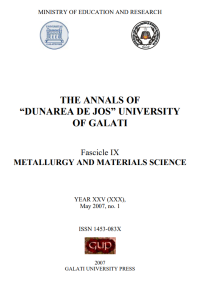Study on the Specific Effects of Corrosion Processes on Ancient Bronze Artefacts
Keywords:
corrosion products, primary, secondary and contamination patina, ancient bronze artefacts, Liesegang effect, perturbed and non-perturbed archaeological sites
Abstract
The paper presents the cases of the corrosion processes which take place on starting from the usage period when the primary patina is being formed and when the secondary patina starts, than continuing with the archaeological site where the contamination patina is obtained under the influence of the pedological processes. The paper is a review from the specialised literature and from the contributions of the authors. There has been used the direct analysis with optical instruments, electron microscopy and EDX.
Downloads
Download data is not yet available.
References
[1]. I. Sandu, A. Dima, I.G. Sandu, Conservation and Restoration of Metallic Artifacts, Ed. Corson, Iasi, 2002.
[2]. I. Sandu, C. Marutoiu, I.G. Sandu, A. Alexandru, A.V. Sandu, Acta Universitatis Cibiensis - Chemia, 9, (2006), 39-53.
[3]. I.G. Sandu, S. Stoleriu, I. Sandu, M. Brebu A.V. Sandu, Revista de Chimie, Bucharest, 56, (2005), 981-994.
[4]. I. Sandu, N. Ursulescu, I.G. Sandu, O. Bounegru, I.C.A. Sandu, A. Alexandru, Corrosion Engineering, Science and Technology, 42, 3, (2007), p. 312.
[5]. W. Mourey, Conservation of Metallic Antiquities – from Archaeological Site to Museum, Ed.Tehnica, Bucharest, 1998.
[6]. I.G. Sandu, I. Sandu, A. Dima, Modern Aspects Concerning the Conservation of Works of Art. Vol. III. Authentication and Restoration of Artifacts from Inorganic Materials, Ed. Performantica, Iaşi, 2006.
[7]. R. Mazzeo, Kermesquaderni, Ed. Nardini, Firenze, 2005, 29-43.
[8]. C.V. Horie and J.A. Vint, Studies in Conservation, 27, (1982), 185.
[9]. J.D. Meakin, L.D. Ames, D.A. Dolske, Atmospheric Environment, 26B, (1992), 207.
[10]. D.A. Scott, Copper and Bronze in Art. Corrosion, Colorants, Conservation, The Getty Conservation Institute, Los Angeles, 2002.
[11]. I. Constantinides, A. Adriaens and F. Adams, Applied Surface Science, 189, (2002), 90-102.
[12]. D.A. Scott, Studies in Conservation, 30, (1985), 49-57.
[13]. W.A. Oddy, N.D. Meeks, Science and Technology in the Service of Conservation, IIC, London, 1982, 119-124.
[14]. R.E. Liesegang, Naturwissenschaftliche Wochenschrift, 11, (1896), 353-362.
[15]. R. Feeney, S.L. Schmidt, P. Strickholm, J. Chadam, P. Ortoleva, Journal of Chemical Physics, 78, (1983), 1293-1311.
[16]. J.B. Keller, S.I. Rubinow, Journal of Chemical Physics, 74, (1981), 5000-5007.
[17]. M. Flicker, J. Ross, Journal of Chemical Physics, 60, (1974), 3458-3465.
[18]. L. Robbiola, J.M. Blengino, C. Fiaud, Corrosion Science, 40, 12, (1998), 2083-2111.
[19]. T.H. Merkel, S.O. Pehkonen, Corrosion Engineering, Science and Technology, 41, 1, (2006), p. 21-37.
[20]. L. Robbiola, I. Queixalos, L.P. Hurtel, M. Pernot, C. Volfovsky, Studies in Conservation, 33, (1988), p. 205-214.
[21]. EFESTUS Project, INCO-MED Contract No. ICA3-CT-2002-10030 (www.efestus.just.edu.jo/index.jsp).
[2]. I. Sandu, C. Marutoiu, I.G. Sandu, A. Alexandru, A.V. Sandu, Acta Universitatis Cibiensis - Chemia, 9, (2006), 39-53.
[3]. I.G. Sandu, S. Stoleriu, I. Sandu, M. Brebu A.V. Sandu, Revista de Chimie, Bucharest, 56, (2005), 981-994.
[4]. I. Sandu, N. Ursulescu, I.G. Sandu, O. Bounegru, I.C.A. Sandu, A. Alexandru, Corrosion Engineering, Science and Technology, 42, 3, (2007), p. 312.
[5]. W. Mourey, Conservation of Metallic Antiquities – from Archaeological Site to Museum, Ed.Tehnica, Bucharest, 1998.
[6]. I.G. Sandu, I. Sandu, A. Dima, Modern Aspects Concerning the Conservation of Works of Art. Vol. III. Authentication and Restoration of Artifacts from Inorganic Materials, Ed. Performantica, Iaşi, 2006.
[7]. R. Mazzeo, Kermesquaderni, Ed. Nardini, Firenze, 2005, 29-43.
[8]. C.V. Horie and J.A. Vint, Studies in Conservation, 27, (1982), 185.
[9]. J.D. Meakin, L.D. Ames, D.A. Dolske, Atmospheric Environment, 26B, (1992), 207.
[10]. D.A. Scott, Copper and Bronze in Art. Corrosion, Colorants, Conservation, The Getty Conservation Institute, Los Angeles, 2002.
[11]. I. Constantinides, A. Adriaens and F. Adams, Applied Surface Science, 189, (2002), 90-102.
[12]. D.A. Scott, Studies in Conservation, 30, (1985), 49-57.
[13]. W.A. Oddy, N.D. Meeks, Science and Technology in the Service of Conservation, IIC, London, 1982, 119-124.
[14]. R.E. Liesegang, Naturwissenschaftliche Wochenschrift, 11, (1896), 353-362.
[15]. R. Feeney, S.L. Schmidt, P. Strickholm, J. Chadam, P. Ortoleva, Journal of Chemical Physics, 78, (1983), 1293-1311.
[16]. J.B. Keller, S.I. Rubinow, Journal of Chemical Physics, 74, (1981), 5000-5007.
[17]. M. Flicker, J. Ross, Journal of Chemical Physics, 60, (1974), 3458-3465.
[18]. L. Robbiola, J.M. Blengino, C. Fiaud, Corrosion Science, 40, 12, (1998), 2083-2111.
[19]. T.H. Merkel, S.O. Pehkonen, Corrosion Engineering, Science and Technology, 41, 1, (2006), p. 21-37.
[20]. L. Robbiola, I. Queixalos, L.P. Hurtel, M. Pernot, C. Volfovsky, Studies in Conservation, 33, (1988), p. 205-214.
[21]. EFESTUS Project, INCO-MED Contract No. ICA3-CT-2002-10030 (www.efestus.just.edu.jo/index.jsp).
Published
2007-05-15
How to Cite
1.
SANDU I, QUARANTA M, BEJINARIU C, SANDU IG, LUCA D, SANDU AV. Study on the Specific Effects of Corrosion Processes on Ancient Bronze Artefacts. The Annals of “Dunarea de Jos” University of Galati. Fascicle IX, Metallurgy and Materials Science [Internet]. 15May2007 [cited 7Jan.2026];30(1):64-3. Available from: https://www.gup.ugal.ro/ugaljournals/index.php/mms/article/view/3179
Issue
Section
Articles



